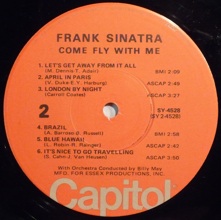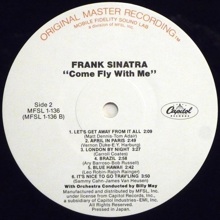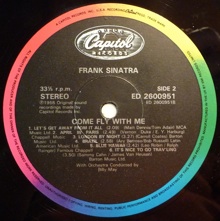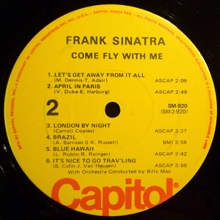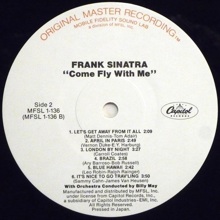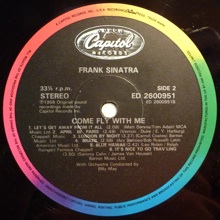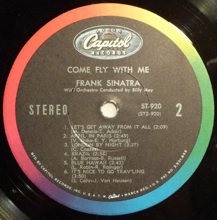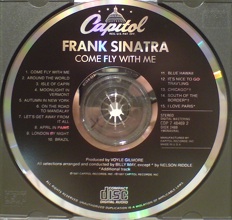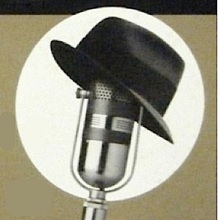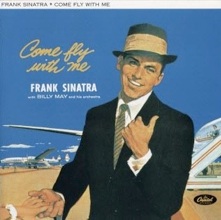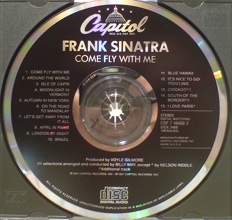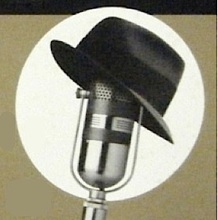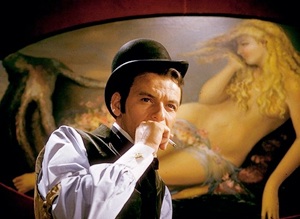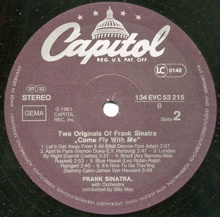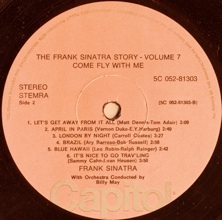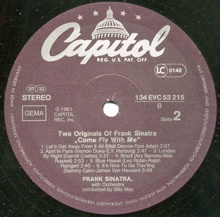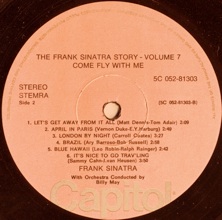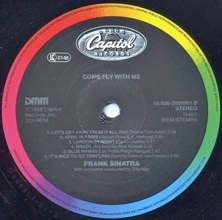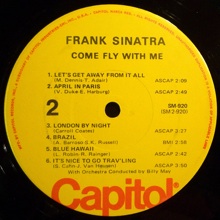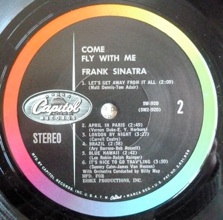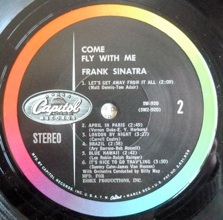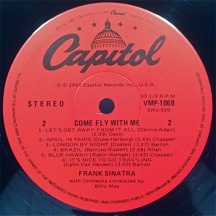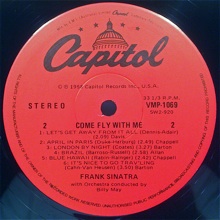Album Index Mono Stereo Conclusions





To my ears, the preamp problems are most audible in these spots:
•Flutes verge on being “downright painful.” Have a listen to the iTunes clips linked at left (click “view” then click “View in iTunes” for longer samples) to hear the flute problems on “Around the World” and “Blue Hawaii.”
•Listen to “Come Fly with Me” and “Brazil” for some very CRUNCHY brass sounds.
•Horribly distorted strings in the last third of “It’s Very Nice to Go Trav’ling.”
The problems are on the three track tape and, thus, all stereo releases. Problems are only on five songs, only on stereo releases. The mono recording, mixed live to mono tape at the session itself, was not affected. For more info, please review page one of this survey.
STEREO LP AUDIO CLIPS:
Let’s Get Away from It All
STEREO CDs
Let’s listen to a few samples. Thanks for SH.TV members “MMM” and “Bob F” for the samples from the Norberg and UK discs! Note: All clips mirror the readily-available free samples at iTunes, linked at right.
First, a track with big-band only, no strings, “Let’s Get Away from It All. Click the photos to hear the samples.

“April in Paris.”
How about a couple of head-to-head comparisons?
The transition occurs at the phrase “This time we’ll peek at the fall...”
-
1.Norberg ---> Walsh. click LetsGetAwayNorberg-Walsh.mp3
-
2.UK 1998 CD ---> Walsh. Click UK98-Walsh.mp3
MFSL & UK “Dell” Pressings: What’s going on?
Both of these 1980s masterings sound very good to me, but there’s something afoot with “Let’s Get Away from It All.” First off, in the instrumental opening, both versions have very different problems. The MFSL has a slight hum in the background, while the UK pressing has some odd “jumpiness” to it, either tape damage or some sort of digital defect. Have a listen, in this order: UK --->MFSL--->UK--->MFSL. Click to listen: GetAwayProblems UK84-MFSL-UK84-MFSL.mp3.
Then, at the end of the same song, the hum on the MFSL fades out during the rill between tracks. In this sample, you will hear:
•UK pressing: The tail end of “Let’s Get Away from It All,” then the blank rill that follows, and the opening note of “April in Paris.”
•The same sequence from the MFSL LP. Note the hum that quickly fades away.
•Repeat of the UK pressing.
•Repeat of the MFSL. Again, listen for the hum.
Click to listen: RillUK-MFSL-UK-MFSL.mp3
That hum only appears on the MFSL version, as far as I know.

Above: Original stereo SW-920 D6 (Scully lathe) LA pressing, courtesy “stevelucille.”
There’s more! Please continue to page 3.
Bonus music alert!!!
When Larry Walsh remixed Brazil, he let the fade at the end go on for several seconds longer than on any other released version. Cool!
Free music! :-)
Did you catch what happened there?
It sounds to me like Mr. Walsh was demonstrating some very sly use of a digital workstation to dodge that distortion in the right channel. [UPDATE: Apparently no digital workstation was in play. See here.] I’m pretty sure he did this during that string passage:
•He took the clean, left channel and ran it through a fake-stereo processor [UPDATE: see link above], so it would provide a reasonable facsimile of the genuine stereo that is present on the vast majority of the CD.
•Maybe there was a little of the distorted left channel mixed in to the center just so those tones were not totally lost, or maybe he blended in a bit of the un-distorted MONO mix. Hard to tell.
Evidence? BELOW you can hear a brief passage that goes in this order:
1.) MFSL
2.) Walsh
3.) MFSL
4.) Walsh
....and here’s what I’d like you to listen for:
During the MFSL, which uses the original, w-i-d-e mix that has distortion in the left track, please focus on the RIGHT channel, and listen for a kind of sloppy slide or glissando in the bowed upright bass. Next, listen for that same drunken bass playing on the Walsh version, and you’ll notice that now it’s over to the right. As the sections repeat, listen for that bass glissando! Audio is here: AroundTheWorldSlideMFSL-Walsh-MFSL-Walsh.mp3.

A mere six weeks shy of the fourth anniversary of the mono LP release of this hit album, Capitol finally (perhaps as yet another jab in the eye of fledgling Reprise Records) released this album in stereo, and, despite the sonic concerns (as outlined on page one of this analysis), it managed to even get some very positive press in, of all places, venerable AUDIO magazine, February 1962:
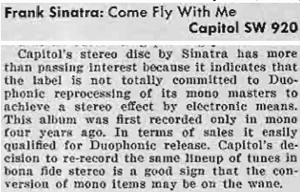
Of course, the album was most definitely NOT a re-recording, but an original 1957 stereo recording that had been sitting “in the can,” unreleased, for years.
Perhaps partially because of it’s spotted release history, and definitely because of some recording defects, the stereo recording of this album has received a bad rap over the years, which is only partially deserved, in my view. Sure, the minimal stereo miking inarguably resulted in some balance issues, but measure-by-measure, song-by-song, the live-mixed, multi-miked mono version is also full of balance problems that strike me as being equally egregious. Similarly, while there’s no debating that the stereo version has obvious technical issues (and resultant distortion) on some tracks, there’s also no debating that the mono version was live-mixed with much more reverb than is found on the stereo mixes. Distorted passages aside, the stereo version also wins in the (to me) all-important arena of tone quality, especially where the vocal is concerned, and since the vocal was picked up -- for both stereo and mono -- via a single Neumann U47 with its signal split between mono and stereo equipment, the difference in tone cannot be atributed to microphone differences, but can be at least partially attributed to the tonal shift caused by heavy reverb and possibly to use of a limiter or EQ added “live” in the mono booth, while the stereo vocal track was captured untampered and dry.
Regardless of one’s fondness or disdain for the stereo mixes, they are definitely DIFFERENT than the mono recording/mix, as evidenced by the clips on page one and below. Additionally, the LP mastering over the years has been largely mediocre, also probably contributing to the stereo mix’s bad reputation.
iTunes provides free 30- or 90-second clips of all songs sampled on this page. All clips on this page fall within that same sample window. Click VIEW above to hear these clips, free of charge.
Above: Circa 1966 ST-920 D4 (Scully lathe) LP, re-using the D4 stamper from the 1961 SW release. (SW is scratched out in deadwax.)
Above: Mid-1970s SM-920 H1 (Scully lathe) LP
Above: Circa 1974 (info source) SY-4528 H1 (Scully lathe) LP
For comparison, here is the mono mix, taken from the excellent 2009 G1 LP:
Above: 1975 Dutch LP (mid-70s repress shown)
Above: 1976 German LP from the “Two Originals of Frank Sinatra” 2-LP set
Above: 1983 MFSL LP, mastered by Jack Hunt
Above: 1984 UK LP (“Penthouse” stamped in deadwax)
Above: 1984 Dutch DMM LP
STEREO LP AUDIO CLIPS:
April in Paris
iTunes provides free 30- or 90-second clips of all songs sampled on this page. All clips on this page fall within that same sample window. Click VIEW above to hear these clips, free of charge.
Above: Circa 1974 (info source) SY-4528 H1 (Scully lathe) LP
Above: 1975 Dutch LP
Above: 1976 German LP from the “Two Originals of Frank Sinatra” 2-LP set
Above: 1983 MFSL LP, mastered by Jack Hunt
For comparison, here is the mono mix, taken from the excellent 2009 G1 LP:
Above: 1984 UK LP (“Penthouse” stamped in deadwax)
Above: 1984 Dutch DMM LP
iTunes provides free 30- or 90-second clips of all songs sampled on this page. All clips on this page fall within that same sample window. Click VIEW above to hear these clips, free of charge.
Above: 1987 CD, remixed by Larry Walsh
Above: 1998 CD, mastered by Robert Norberg
Above: 1998 UK CD from “The Capitol Years” boxed set

Above: 1987 CD, remixed by Larry Walsh
Above: 1998 CD, mastered by Robert Norberg
Above: 1998 UK CD from “The Capitol Years” boxed set
How about reverb levels?
Here are four brief clips, in this order:
-
1.2009 Capitol mono reissue LP
-
2.MFSL stereo
-
3.UK 1998 stereo CD
-
4.1987 Walsh remixed stereo CD
Click to listen: 48 2009Mono-MFSL-UK98-Walsh.aif
How bad is the distortion on the stereo tracks with the inherent distortion due to technical problems at the session?
Here are three clips of the “high strings” section from “Around the World,” in this order.
1.) Excellent 2009 Capitol mono LP -- remember: this is actually a simultaneous, different recording (of the same performance!) than the stereo mix, i.e., different mics, different mixing console, different tape machines, all mixed live with reverb during the session. The distortion problem was in the electronics (console) of the STEREO recording, so this mono version is “clean” -- no defect.
2.) Excellent 1983 MFSL stereo LP - this uses the original stereo mix. Listen for the extremely wide spread on the strings and the crunchy distortion in the right channel.
3.) Excellent 1987 Capitol CD - remixed from the 3-track (stereo) session tapes by Larry Walsh. Note that the spread on the strings is greatly diminished, as is the crunch.
Click on Frank Sinatra’s picture below to hear the audio:
Above: Original stereo SW-920 D6 (Scully lathe) LA pressing, courtesy “stevelucille.”
Above: Circa 1966 ST-920 D4 (Scully lathe) LP, re-using the D4 stamper from the 1961 SW release. (SW is scratched out in deadwax.)
Above: Mid-1970s SM-920 H1 (Scully lathe) LP
Above: 1979 Australian LP, catalog # VMP 1069
Above: 1979 Australian LP, catalog #VMP 1069
